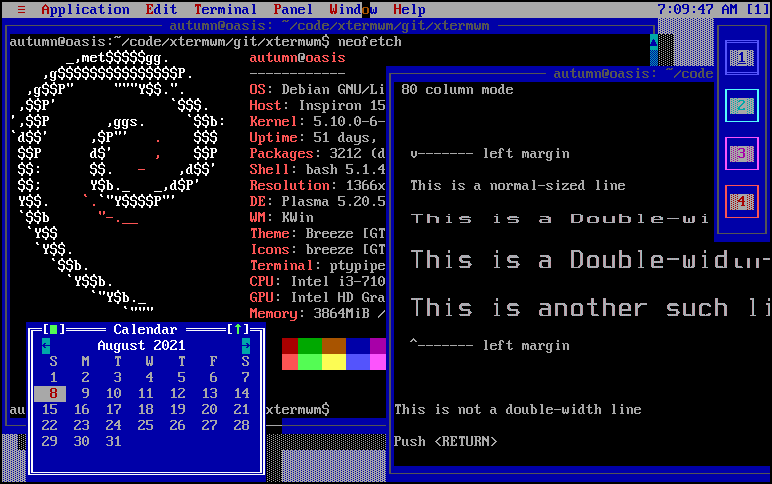

Xdg-mime default sktop application/pdf & # Loop while true do # Set root title The suggested link to Why doesn't xterm support double-sized characters when using Xft fonts? is for a different problem.Xbindkeys & # Set some defaults export BROWSER =chromium & export EDITOR =vim & It simply overwrites adjacent characters with the erroneous pixels:

If you have xtermcontrol installed, then you can get the value which is currently used for one of these, e. The color (s) for blue are color4 (normal) and color12 (bright). Here is a screenshot showing that gnome-terminal does not clip the characters, nor does it interpret those as double-width. In Debian (and derived distributions such as Ubuntu), there is a package xtermcontrol which makes it simple to send escape sequences to set the xterm color palette. Xterm does have a way to adapt to narrow/wide choices for ambiguous width characters, but changing the width of neutral characters is not a feature of xterm.
#Customize uxterm manual
See the xterm manual page for more information on xterm-options. All arguments to uxterm are passed to xterm without processing the -class and -u8 options should not be specified because they are used by the wrapper. From xterm's standpoint, the problem is likely in the fontconfig metrics. uxterm is a wrapper around the xterm(1) program that invokes the latter program with the UXTerm X resource class set. If the terminal uses the font-width, users are confused (because terminal programs are written for a fixed-pitch grid of rows/columns).Ĭorrecting that problem (and making fonts useful to everyone) is what fontconfig is supposed to do. If the terminal (like xterm) clips the character, users are displeased. However, some fonts are (unsurprisingly) developed by East Asians, and have made most of the neutral characters in those fonts double-width. That N means neutral: if the characters were used in an East-Asian context, an implementation could treat them as "full-width" (a misleading term for double-width). EastAsianWidth.txt (see TR11-38) has this information:ġD4A9.1D4AC N # Lu MATHEMATICAL SCRIPT CAPITAL N.MATHEMATICAL SCRIPT CAPITAL QġD49E.1D49F N # Lu MATHEMATICAL SCRIPT CAPITAL C.MATHEMATICAL SCRIPT CAPITAL D UnicodeData.txt gives this information:ġD4AB MATHEMATICAL SCRIPT CAPITAL P Lu 0 L 0050 N ġD49F MATHEMATICAL SCRIPT CAPITAL D Lu 0 L 0044 N īut refers you to the EastAsianWidth.txt file for the actual width.


Uses U+1D4AB and U+1D49F, which xterm and the system agree should occupy one cell on the screen. In some cases, the system's wcwidth is not up-to-date to handle some special characters, and xterm will unnecessarily truncate the cell. Some fonts are worse than others fontconfig doesn't help in this area. For urxvt - it's probably simply ignoring the glyph, since it doesn't follow the font-metrics. fontconfig silently uses its default font for this. By the way, "fixed" is probably not an entry in fc-list output. xterm generally uses the system's wcwidth function to get a (more) correct estimate of individual character width, and when drawing characters clips, and the erroneous pixels are lost. With xterm, the problem is that the first/last characters go outside the bounding-box which xterm reads from the fontconfig metrics.


 0 kommentar(er)
0 kommentar(er)
